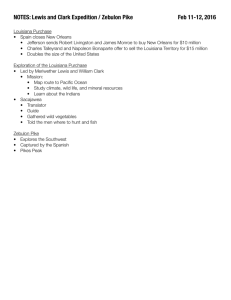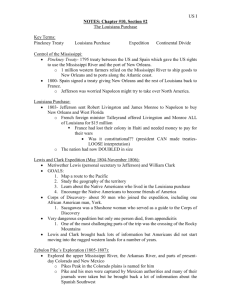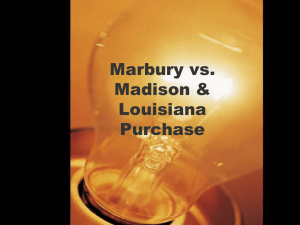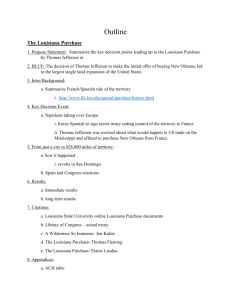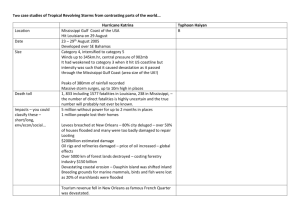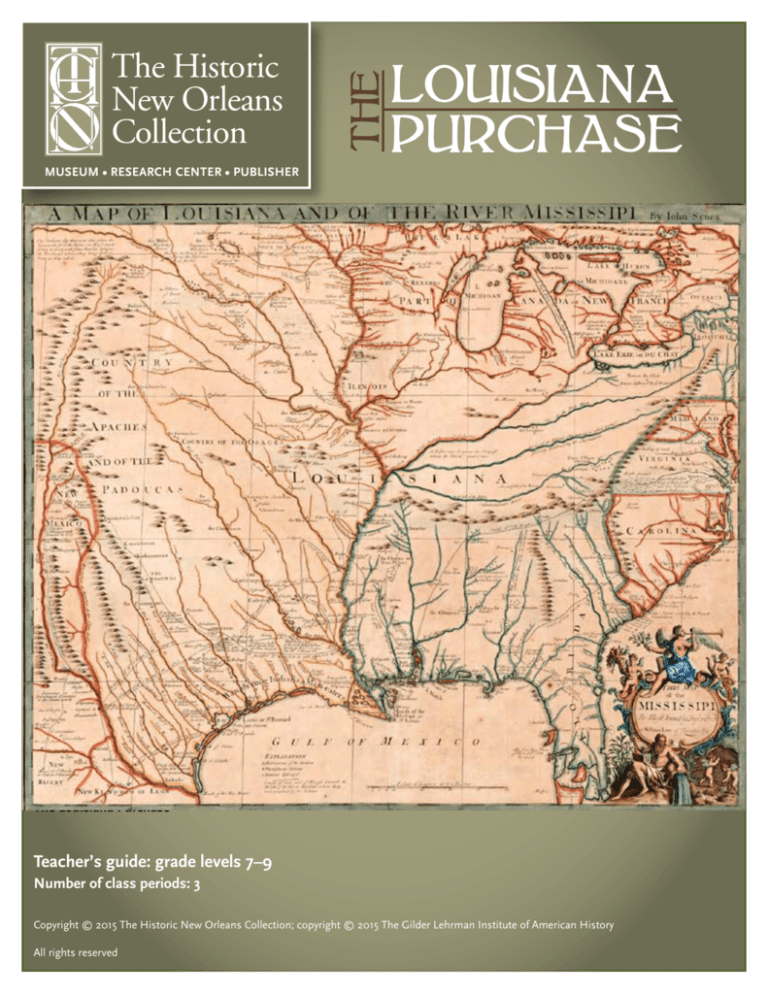
The Historic
New Orleans
Collection
THE
THE LOUISIANA PURCHASE
LOUISIANA
PURCHASE
1
MUSEUM • RESEARCH CENTER • PUBLISHER
The Louisiana Purchase
Teacher’s guide: grade levels 7–9
Number of class periods: 3
Copyright © 2015 The Historic New Orleans Collection; copyright © 2015 The Gilder Lehrman Institute of American History
AllCopyright
rights reserved
© 2015 The Historic New Orleans Collection | www.hnoc.org | copyright © 2015 The Gilder Lehrman Institute of American History | www.gilderlehrman.org
2
THE LOUISIANA PURCHASE
The Louisiana Purchase
Metadata
Grade levels 7–9
Number of class periods: 3
What’s Inside:
Lesson One....p. 4
Lesson Two....p. 8
Lesson Three....p. 15
Common Core Standards
CCSS.ELA-LITERACY.RI.8.1: Cite the textual evidence that most strongly supports an analysis of what the text says
explicitly as well as inferences drawn from the text.
CCSS.ELA-LITERACY.RI.8.2: Determine a central idea of a text and analyze its development over the course of the text,
including its relationship to supporting ideas; provide an objective summary of the text.
CCSS.ELA-LITERACY.RI.8.3: Analyze how a text makes connections among and distinctions between individuals, ideas,
or events (e.g., through comparisons, analogies, or categories).
CCSS.ELA-LITERACY.RI.8.4: Determine the meaning of words and phrases as they are used in a text, including
figurative, connotative, and technical meanings; analyze the impact of specific word choices on meaning and tone,
including analogies or allusions to other texts.
CCSS.ELA-LITERACY.RI.8.5: Analyze in detail the structure of a specific paragraph in a text, including the role of
particular sentences in developing and refining a key concept.
CCSS.ELA-LITERACY.RI.8.6: Determine an author’s point of view or purpose in a text and analyze how the author
acknowledges and responds to conflicting evidence or viewpoints.
CCSS.ELA-LITERACY.RI.8.7: Evaluate the advantages and disadvantages of using different mediums (e.g., print or
digital text, video, multimedia) to present a particular topic or idea.
CCSS.ELA-LITERACY.RI.8.8: Delineate and evaluate the argument and specific claims in a text, assessing whether the
reasoning is sound and the evidence is relevant and sufficient; recognize when irrelevant evidence is introduced.
CCSS.ELA-LITERACY.RI.8.9: Analyze a case in which two or more texts provide conflicting information on the same
topic and identify where the texts disagree on matters of fact or interpretation.
CCSS.ELA-LITERACY.W.8.1: Write arguments to support claims with clear reasons and relevant evidence.
CCSS.ELA-LITERACY.W.8.2: Write informative/explanatory texts to examine a topic and convey ideas, concepts, and
information through the selection, organization, and analysis of relevant content.
The Historic New Orleans Collection, 533 Royal Street, New Orleans, LA 70130-2179
Contact: Daphne L. Derven, curator of education, (504) 598-7154, daphned@hnoc.org
Jenny Schwartzberg, education coordinator, (504) 556-7661, jennifers@hnoc.org
Cover: Map of Louisiana and of the River Mississippi, by John Senex, publisher; engraving with watercolor; 1721; The
Historic New Orleans Collection, 1972.8
Copyright © 2015 The Historic New Orleans Collection | www.hnoc.org | copyright © 2015 The Gilder Lehrman Institute of American History | www.gilderlehrman.org
THE LOUISIANA PURCHASE
3
Overview
Over the course of three lessons, the students will explore events that led to the United States’ purchase of the
Louisiana Purchase territory from France in 1803. Students will analyze key letters from US officials regarding the
negotiations for the purchase of New Orleans that ultimately resulted in a much larger purchase, doubling the land
in the United States. Students also will examine and evaluate maps of the area to understand the impact of the
Purchase.
Essential Questions
1. Why was the Louisiana Purchase territory important to the United States?
2. Under what circumstances was the United States able to purchase this territory?
La Louisiane et Pays Voisins, by Jacques Nicolas Bellin, cartographer; engraving with watercolor; 1763; The Historic
New Orleans Collection, 1975.35
Copyright © 2015 The Historic New Orleans Collection | www.hnoc.org | copyright © 2015 The Gilder Lehrman Institute of American History | www.gilderlehrman.org
THE LOUISIANA PURCHASE
4
Lesson One
Objective
In this lesson, students will read about and understand the key events in the negotiations with France for the
United States’ purchase of New Orleans (and ultimately Louisiana). A timeline will help students understand the
sequence of events and the impact of various negotiations on the final purchase.
Introduction
The Port of New Orleans and the Mississippi River were critically important to American trade, and President
Thomas Jefferson knew that American possession of the port was vital to the country’s future. France owned New
Orleans until 1762, when the colony of Louisiana was ceded to Spain. The Spanish held the port city for several
decades, transferring Louisiana back to France in 1800 but maintaining administrative control through 1803. In
that year, President Jefferson sent negotiators to France with instructions to buy New Orleans. However, instead of
simply acquiring the city, the United States acquired some 530 million acres, greatly increasing the size of the US
and assuring the nation control of the important Mississippi River. The explanation and timeline will help students
understand the sequence of events and the impact each had on the ultimate purchase of this vast territory.
Materials
Narrative
Timeline
Critical thinking questions from the narrative and timeline
Procedures
1. Distribute copies of the narrative and timeline.
2. Share read with the students, modeling prosody, inflection, and punctuation. Ask the students to join in with the reading after a few sentences, and continue reading.
3. Distribute the critical thinking questions for the narrative. Model the process for the students by leading the class in completing the first two questions. The teacher may allow students to work in groups of two or three,
but each student must complete his or her own answers to the critical thinking questions, and each answer
must be based on the narrative texts.
4. Facilitate a class discussion where students share their answers to the questions and develop a clear
understanding of the events that led to the United States’ purchase of the Louisiana Purchase territory and the
impact this purchase had on America.
Copyright © 2015 The Historic New Orleans Collection | www.hnoc.org | copyright © 2015 The Gilder Lehrman Institute of American History | www.gilderlehrman.org
THE LOUISIANA PURCHASE
Handout
5
Share Read
Louisiana Purchase Narrative
“Introduction” to Between Colony and State: Louisiana in the Territorial Period, 1803–1812,
a THNOC exhibition catalog (2009–10)
by John T. Magill, Pamela D. Arceneaux, and John H. Lawrence,
The Historic New Orleans Collection
La Louisiane,1 as the North American colony under French governance was called, had poorly defined boundaries to
the east and west. Cartographers wishing to promote French hegemony2 in North America showed it extending from
Canada to the Gulf of Mexico and from the Appalachian Mountains to the Pacific Ocean, though this conflicted with
British and Spanish holdings to the east and west. In 1762, France ceded3 la Louisiane to Spain, its ally in the Seven
Years’ War, and it remained a Spanish colony through 1800, when it was returned to France via the secret treaty of San
Ildefonso. The Spanish colony, la Luisiana4 in practice and la Louisiane in fact, remained under Spanish rule from 1800
to 1803.
Even though Thomas Jefferson had strong ties to France, he understood that French ownership of New Orleans
posed a potential threat to the United States. As a Mississippi River gulf port and military port, New Orleans’s
strategic location was critical to economic trade and military travel. When France took possession of New Orleans
in 1803, it closed the port to Americans, so President Jefferson sent envoys5 to France to try to arrange its purchase.
Circumstances played into American hands when France failed to suppress a slave rebellion in Haiti. One hundred
thousand slaves, inspired by the French Revolution, had revolted and destroyed coffee and sugar plantations. With the
conflict in Haiti going badly, Napoleon believed he had less need for New Orleans. Additionally, renewed hostilities
with Britain seemed likely, so Napoleon had little interest in keeping Louisiana and he had a great need for money to
pay for France’s multiple wars. On April 11, 1803, France offered to sell not just New Orleans but its claim to the entire
province of Louisiana. On April 30, the American negotiators agreed to a price of $15 million (or about four cents
an acre) and signed the Louisiana Purchase Treaty. For just $5 million more than he planned to spend buying New
Orleans, Jefferson doubled the size of the country. In a ceremony in New Orleans on November 30, 1803, the period of
indeterminacy6 ended, and Spain formally retroceded7 the colony to France—setting the stage for France’s transfer of
the territory to the US, on December 20.
The exact physical boundaries of the territory were not understood or clarified and served as the subject of future
disputes and negotiations. American administrators made more precise designations, dividing the vast territory
into Lower Louisiana (land below the confluence of the Mississippi and Ohio rivers) and Upper Louisiana. In 1804,
Congress carved the territory of Orleans from Lower Louisiana as a separate governmental entity; this territory roughly
conformed to the contours of today’s state of Louisiana. The remainder of the Louisiana Purchase became the District
of Louisiana, which was renamed the Missouri Territory after Louisiana was admitted to the Union as a state in 1812.
Even with these attempts to clarify the territory’s borders, boundary disputes persisted until 1819, when the US and
Spain signed the Adams-Onis Treaty, fixing the state’s southwestern limits.
1
2
3
4
5
6
7
This is the French term for the Louisiana territory.
Political control
Transfer of land
This is the Spanish term for the Louisiana territory.
Messengers or representatives
Vagueness or undecidedness
To cede back a piece of land to its previous owner
Copyright © 2015 The Historic New Orleans Collection | www.hnoc.org | copyright © 2015 The Gilder Lehrman Institute of American History | www.gilderlehrman.org
THE LOUISIANA PURCHASE
Handout
6
Share Read
Louisiana Purchase Timeline
written and compiled by Kathy White
The Gilder Lehrman Institute of American History
1683
The name Louisiana first appeared on maps; it had been claimed in the name of Louis XIV the previous year.
1762
France ceded Louisiana to Spain (its ally in the Seven Years’ War).
1800
Spain returned Louisiana to France (Secret Treaty of San Ildefonso).
1801
President Jefferson appointed Robert Livingston US minister to France.
April 1802
President Jefferson wrote to Livingston about the importance of buying New Orleans.
Jan. 1803
President Jefferson sent James Monroe to assist Livingston in the attempt to purchase New Orleans and West Florida from France for up to $10 million.
The slave revolt in Haiti overwhelmed Napoleon, who needed money to go to war with Britain.
April 1803
France offered Livingston and Monroe all of Louisiana (not just New Orleans).
Livingston and Monroe signed a treaty for $15 million to purchase approximately 828,000 square miles; this doubled the national territory, although it took some time for the exact boundaries to be determined and understood.
Oct. 20, 1803
The US Senate ratified the Louisiana Purchase Treaty.
Nov. 30, 1803
In a transfer ceremony in New Orleans, Spain retroceded the colony to France.
Dec. 20, 1803
France transferred the Louisiana Purchase territory to the US.
1804
The US Congress established Orleans Territory as a separate government entity (from Lower LA)
1812
Louisiana was admitted to the Union as a state.
1819
The Adams-Onis Treaty fixed Louisiana’s southwestern limits.
Copyright © 2015 The Historic New Orleans Collection | www.hnoc.org | copyright © 2015 The Gilder Lehrman Institute of American History | www.gilderlehrman.org
THE LOUISIANA PURCHASE
7
Graphic Organizer
Critical Thinking Questions from Narrative and Timeline
Name: ______________________________________________________ Date: _______________________________
1. How did the ownership of Louisiana change in 1762? __________________________________________________
______________________________________________________________________________________________
2. How did the ownership of Louisiana change in 1800?__________________________________________________
______________________________________________________________________________________________
3. Even though no longer the actual owner of Louisiana, which country actually ruled it from 1800 to 1803?
______________________________________________________________________________________________
4. What action occurred November 30, 1803?___________________________________________________________
______________________________________________________________________________________________
5. How did the situation in Haiti impact France? ________________________________________________________
______________________________________________________________________________________________
6. What need did Napoleon have? Why? _______________________________________________________________
______________________________________________________________________________________________
7. What offer did France make? Why? _________________________________________________________________
______________________________________________________________________________________________
8. What impact did the purchase have on America?______________________________________________________
______________________________________________________________________________________________
9. How did the United States initially attempt to resolve the poorly defined boundaries? ________________________
______________________________________________________________________________________________
10. Name the greatest reason the US wanted to acquire New Orleans. Why was this so important? ________________
______________________________________________________________________________________________
Copyright © 2015 The Historic New Orleans Collection | www.hnoc.org | copyright © 2015 The Gilder Lehrman Institute of American History | www.gilderlehrman.org
THE LOUISIANA PURCHASE
8
Lesson Two
Ciphers & Secret Communications
Objective
Students will analyze two letters: the first is from Thomas Jefferson to Robert Livingston, written on April 18, 1802,
explaining the importance of the Louisiana territory and discussing the need to use a secret code (also called a
cipher or cypher) in their communications; the second is from Livingston to Secretary of State James Madison,
sent at midnight on April 13, 1803, and delivering the dramatic news that Napoleon had unexpectedly offered to
sell not just New Orleans but the entire Louisiana territory. Through their analysis of these letters, students will
develop a deeper understanding of the criticality of the negotiations for the United States, as well as Jefferson’s
reasons for designing a cipher.
Introduction
In the first letter, President Thomas Jefferson stresses the importance of Louisiana and explains the reasons the
territory is so critical to the United States. Jefferson, who has strong ties to the French, explains to Livingston
the need for a cipher as well as the rationale behind its design. In the second letter, Robert Livingston informs
Secretary of State James Madison of Napoleon’s offer to sell the entire Louisiana territory to the United States.
Livingston encoded the key parts of the letter with a cipher to keep it confidential, and the cipher has been
decoded in another hand.
Materials
Excerpt from letter from Thomas Jefferson to Robert Livingston, April 18, 1802
Graphic organizer for Jefferson letter
Excerpt from letter from Robert Livingston to James Madison, April 13, 1803
Graphic organizer for Livingston letter
Activity sheet for student creation of a cipher
Procedures
1. Distribute copies of the excerpt from Jefferson’s letter to Robert Livingston.
2. Share read with the students, modeling prosody, inflection, and punctuation. Ask the students to join in with
the reading after a few sentences, and continue reading.
3. Distribute the graphic organizer for the Jefferson letter. Model the process for the students by leading the class
in completing the first question. The teacher may allow students to work in groups of two or three, but each
student must complete his or her own graphic organizer to demonstrate understanding of the text.
4. Facilitate a class discussion where students share their answers.
5. Repeat steps 1–4 with the excerpt from Robert Livingston’s letter to James Madison.
6. Distribute the activity sheet for the student creation of a cipher. Have students complete the first question, and
then lead a discussion of appropriate examples in question one. When students have a good understanding of
the assignment, tell them to complete the rest of the assignment to create and use a cipher. Once everybody
has completed the assignment, encourage students to share their cipher and have the class evaluate the
effectiveness of each cipher.
Copyright © 2015 The Historic New Orleans Collection | www.hnoc.org | copyright © 2015 The Gilder Lehrman Institute of American History | www.gilderlehrman.org
THE LOUISIANA PURCHASE
Handout
9
Share Read
Excerpt from Letter from
Thomas Jefferson to Robert Livingston, April 18, 1802
excerpt taken from http://jeffersonswest.unl.edu/archive/view_doc.php?id=jef.00124
A favorable and a confidential opportunity offering by Mr. Dupont de Nemours, who is revisiting his native country
gives me an opportunity of sending you a cypher to be used between us, which will give you some trouble to
understand, but, once understood, is the easiest to use, the most indecypherable, and varied by a new key with the
greatest facility of any one I have ever known. I am in hopes the explanation inclosed will be sufficient. Let our key
of letters be [Series of characters, most of which are illegible] and the key of lines be [figures illegible] and lest we
should happen to lose our key or be absent from it, it is so formed as to be kept in the memory and put upon paper
at pleasure; being produced by writing our names and residences at full length, each of which containing 27 letters is
divided into two parts of 9 letters each; and each of the 9 letters is then numbered according to the place it would hold
if the 9 were arranged alphabetically, thus [illegible] alphabetically arranged would be [unclear]. The numbers over the
letters being then arranged as the letters to which they belong stand in our names, we can always construct our key.
But why a cypher between us, when official things go naturally to the Secretary of State, and things not political need
no cypher? 1 matters of a public nature, and proper to go on our records, should go to the Secretary of state.
2 matters of a public nature not proper to be placed on our records may still go to the secretary of state, headed by the
word “private.” But 3 there may be matters merely personal to ourselves, and which require the cover of a cypher more
than those of any other character. This last purpose and others which we cannot foresee may render it convenient and
advantageous to have at hand a mask for whatever may need it.
Copyright © 2015 The Historic New Orleans Collection | www.hnoc.org | copyright © 2015 The Gilder Lehrman Institute of American History | www.gilderlehrman.org
THE LOUISIANA PURCHASE
10
Graphic Organizer
Name: _____________________________________________________
Date: ______________________________
1. Explain what a cipher is and why one might be used.
_____________________________________________________________________________________________
_____________________________________________________________________________________________
_____________________________________________________________________________________________
2. Have there been any moments in your own life when a code or cipher might have come in handy? Explain.
_____________________________________________________________________________________________
_____________________________________________________________________________________________
_____________________________________________________________________________________________
3. Paraphrase in your own words why Jefferson believed a cipher was needed in 1802.
_____________________________________________________________________________________________
_____________________________________________________________________________________________
_____________________________________________________________________________________________
4. Explain how the key to Jefferson’s cipher was constructed.
_____________________________________________________________________________________________
_____________________________________________________________________________________________
_____________________________________________________________________________________________
Copyright © 2015 The Historic New Orleans Collection | www.hnoc.org | copyright © 2015 The Gilder Lehrman Institute of American History | www.gilderlehrman.org
THE LOUISIANA PURCHASE
Handout
11
Share Read
Excerpts from Letter from
Robert Livingston to James Madison, April 13, 1803
The Historic New Orleans Collection, 78-56-L, MSS 132
Significant figures mentioned in the letter:
1. François Barbé-Marbois, the French Minister of the Treasury
2. Napoleon Bonaparte, First Consul of France (also referred to as Consul)
3. Charles Maurice de Talleyrand-Périgord, the French foreign minister
4. James Monroe (spelled in the letter as Munroe), American politician who worked with Livingston to purchase
the Louisiana territory; later served as the fifth President of the United States (1817–1825)
5. James Madison, American Secretary of State during the Louisiana Purchase; later served as the fourth
President of the United States (1809–1817)
Note: italics in the text represent the translation of the numeric code.
Consul came again to him [François Barbé-Marbois] & spoke to him about the troubles that were excited in America
& enquired how far I was satisfied with his last note. Here some civil things were introduced for which I presume I
am more indebted to the Minister’s politeness than to his veracity, so let them sleep. He [Barbé-Marbois] then took
occasion to mention his sorrow that any cause of difference should exist between our countries. The Consul told
him in reply, “will you have the charge of the treasury let them give you 1239.53.738 one hundred million & pay their
own claims, & take the whole country. Seeing by my looks that I was surprised at so extravagant a demand, he added
that he considered the demand as exorbitant, & had told the First Consul that the thing was impossible, that we had
not the means of arising it, that the consul told him we might borrow it. I now plainly saw the whole business. First
Consul was disposed to sell, 625.913.150.444.1059.129.1389.829.1737.1698.210.1290.1221.968.1156.1221.968.1282.642.1
456.961.849.1140.1637.1667.759.849.806.968.613.1461.968.901.1221.518.1126.1467.681.40.715.1656.955.50.993.1467.45
”next he distrusted Talleyrand on account of the business of the supposed intention to bribe and meant to put the negotiation
into the hands of Marbois whose character for integrity is established.
I told him [François Barbé-Marbois] that the United States were anxious to preserve peace with France, that for that
reason they wished to remove them to the West Side of the Mississippi that we would be perfectly satisfied with New
Orleans & the Floridas & had no disposition to extend across the River, that of course we would not give any great
sum for the purchase, that he was right in his idea of the extreme exorbitancy of the demand which would not fall
short of 1239.53.1661.990.1392.738 one hundred and twenty five millions that however we would be ready to purchase
provided the sum was reduced to reasonable limits. He then pressed me to name the sum…I told him that we had no
sort of authority to go to a sum that bore any proportion to what he mentioned, but that as he himself considered the
demand as too high he would oblige me by telling me what he thought to be reasonable. He replied that if we should
name 253.738 sixty million & take upon us the American claims to the amount of 990.307 twenty more he would try how
far it would be accepted.
Copyright © 2015 The Historic New Orleans Collection | www.hnoc.org | copyright © 2015 The Gilder Lehrman Institute of American History | www.gilderlehrman.org
THE LOUISIANA PURCHASE
12
I asked [Barbé-Marbois] to press…upon [Napoleon]…the danger of seeing the country pass into the hands of Britain.
I told him that he had seen the ardour of the Americans to take it by force, & the difficulty with which they were
restrained by the prudence of the President, that he must easily see how much the hands of the war party would be
strengthened when they learned that France was upon the eve of a rupture with England. He admitted the weight of
this, “but says he, you known the temper of a youthful conqueror–’everything he does is rapid as lightening; we have
only to speak to him as an opportunity presents itself, perhaps in a crowd 96.913.1639.640.112.169.131.1463.96.1011.16
84.1675.1239.689.1437.1011.1167.1051.180.1038.307.729.1488.1667.913.8.959.1157.1087.64 when he bears no contradiction;
when I am alone with him I can speak more freely and he attends but this opportunity seldom happens & is always
accidental. Try then if you can not come up to my mark. Consider the extent of the country, the exclusive navigation of
the River, & the importance of having no neighbors to dispute with you, no war to dread. I told him that I considered
all these as important considerations, but there was a point beyond which we could not go, & that fell far short of the
sum he mentioned.
Sir, you see a negotiation is fairly opened 1667.696.1419-100.1011.1169.461.1011.651.1561.849.1675.2021180.1012.1044.657.583.1515-1648.1675.82.869.260.1690.243.555.304.860.1610.1467.1456.1576.1033.1488.651.1561.169
2.1657.849.968.810.981.1489.1011.911.470.503.80.640.421.968.1564.1358.1249.608.849.599.1467.1456.1576.1033.1488
.1048.822.966.2 11.1456.1068.1463-1175.957.1050u.968.68.1370.671. 1456.126.1657.1459.1667.968.1046.139307.968.1
607.809.955.849.244.1038.968.38.1032.365.85.1550.1409.968.924.626.965.802”1159.518.1126.1467.340.1011.538.1069
.1607.324.376.967.968.679.1078.530.1607.826.460.1169.968.453.1221.968.962.1031.432.92.1221.968.945.689.968.125
9.1221.259.571.348.993.849.260.648.1456.1375.681.580.1199.637.83.363.408.1554. and upon grounds I prefer to all other
commercial privileges and always to some simple money transaction is infinitely preferable. As to the quantum I have yet
made no opinion; the field opened to us is infinitely larger than our instructions contemplated, the revenue increasing and the
land more than adequate to sink the Capital, should we even go the proposed by Mr. Marbois; nay I persuade myself that the
whole sum may be raised by the sale of the Territory West of the Mississippi, but with the right of sovereignty to some power
in Europe whose vicinity we should not fear.
I speak now without reflection & without having seen Mr Munroe, as it was midnight when I left the treasury office it
is now three O’clock-it is so very important that you should be appraised there a negotiation is actually opened even
before Mr Munroe has been presented in order to calm the tumult which the news of war will renew, that I have lost
no time in communicating it. We shall do all we can to 24.180.638.968.804.838.1669.1157.324.650.379.1434.1526.146
7.967.83.390.1158 cheapen the purchase but my present sentiment is that we shall buy. I trust it will be necessary to put
some proposition, tomorrow the Consul goes in a few days to Brussels & every moment is precious.
Copyright © 2015 The Historic New Orleans Collection | www.hnoc.org | copyright © 2015 The Gilder Lehrman Institute of American History | www.gilderlehrman.org
THE LOUISIANA PURCHASE
13
Graphic Organizer
Name: ____________________________________________________
Date: ________________________________
1. What was Livingston’s reaction when Barbé-Marbois proposed the sale of the entire Louisiana territory?
Why do you think he reacted in this manner?
______________________________________________________________________________________________
______________________________________________________________________________________________
2. How did Barbé-Marbois describe Napoleon’s temperament?
______________________________________________________________________________________________
______________________________________________________________________________________________
3. How did Barbé-Marbois and Livingston try to negotiate a compromise?
______________________________________________________________________________________________
______________________________________________________________________________________________
4. List three or four pieces of information that Livingston communicated using a cipher.
______________________________________________________________________________________________
______________________________________________________________________________________________
5. Look for patterns in the coded information. What sort of material did Livingston choose to present in code?
______________________________________________________________________________________________
______________________________________________________________________________________________
6. What might have been his reasons for coding this information rather than the other information?
______________________________________________________________________________________________
______________________________________________________________________________________________
Copyright © 2015 The Historic New Orleans Collection | www.hnoc.org | copyright © 2015 The Gilder Lehrman Institute of American History | www.gilderlehrman.org
14
THE LOUISIANA PURCHASE
Graphic Organizer
Student Creation of a Cipher
Name: _____________________________________________________ Date: _________________________________
1. How are contemporary uses of ciphers similar to the ciphers discussed by Jefferson? Give examples and explain.
________________________________________________________________________________________________
________________________________________________________________________________________________
2. How are the contemporary uses of ciphers different from the ciphers discussed by Jefferson? Give examples and
explain.__________________________________________________________________________________________
________________________________________________________________________________________________
________________________________________________________________________________________________
3. Are there historical or technological reasons that codes work differently in different periods?____________________
________________________________________________________________________________________________
________________________________________________________________________________________________
4. One basic type of cipher was developed by Julius Caesar. In a Caesar cipher, each letter of the alphabet is shifted a
certain number of spaces to create a letter to letter code. Here is an example of a Caesar cipher with a three-letter
shift:
A
D
B
E
C
F
D
G
E
H
F
I
G
J
H
K
I
L
Original Alphabet
Coded Alphabet
Thus, an encrypted message reading KLGH would be decrypted to read HIDE.
Create your own Caesar cipher below and use it to create a message.
A
B
C
D
E
F
G
H
I
J
K
L
M
Original Alphabet
Coded Alphabet
N
O
P
Q
R
S
T
U
V
W
X
Y
Z
Original Alphabet
Coded Alphabet
Message: _______________________________________________________________________________________
________________________________________________________________________________________________
________________________________________________________________________________________________
5. In what circumstances might you consider creating and using a cipher? Why? How? __________________________
________________________________________________________________________________________________
For more activities and information on ciphers, visit https://www.nsa.gov/kids/home_html.shtml
Copyright © 2015 The Historic New Orleans Collection | www.hnoc.org | copyright © 2015 The Gilder Lehrman Institute of American History | www.gilderlehrman.org
THE LOUISIANA PURCHASE
15
Lesson Three
Reading the Louisiana Purchase through Maps
Objective
In this lesson, students will understand (1) the magnitude of the land area acquired by the US, (2) the vagueness
of the actual boundaries, and (3) the financial deal the US made with France, especially compared to Jefferson’s
original plan. Students also will analyze and understand the impact of the area the US purchased.
Introduction
President Jefferson sent Livingston to France to purchase New Orleans and as much of the Gulf Coast as possible
for up to $10 million, hoping to gain access to and control of the Mississippi River. As shown in the earlier
lessons, the United States actually acquired the entire Louisiana Purchase territory of approximately 828,000
square miles, even though the exact boundaries were not known or defined. The purchase did, however, more than
double the size of the United States for a mere $15 million, or approximately four cents an acre.
Materials
Map of Louisiana and the Mississippi River (1721)
Map of New Orleans (1759)
Map of Louisiana and Neighboring Countries (1763)
Map of Louisiana (1805)
Graphic organizer of critical thinking questions
Procedures
1. Distribute copies of the four maps.
2. Ask students to refer to the maps and discuss why Jefferson was interested in buying New Orleans and the
Gulf Coast. Students must provide evidence to support their answers.
3. Distribute the critical thinking questions. Model the process for the students by leading the class in completing the first question. Students may work in groups of two or three, but each student must complete his or her
own answers to the questions, and each answer must be based on the images.
4. Facilitate a class discussion where students share their answers to the questions and develop a clear understanding of the impact of the United States’ acquisition of the Louisiana Purchase territory.
5. Optional: At the conclusion of the discussion, assign an essay for students to write on one of the two Essential
Questions posed on page 3 of this lesson plan.
Copyright © 2015 The Historic New Orleans Collection | www.hnoc.org | copyright © 2015 The Gilder Lehrman Institute of American History | www.gilderlehrman.org
THE LOUISIANA PURCHASE
16
Map of Louisiana and the Mississippi River (1721)
Map of Louisiana and of the River Mississippi, by John Senex, publisher; engraving with watercolor;
1721; The Historic New Orleans Collection, 1972.8
Copyright © 2015 The Historic New Orleans Collection | www.hnoc.org | copyright © 2015 The Gilder Lehrman Institute of American History | www.gilderlehrman.org
THE LOUISIANA PURCHASE
17
Map of New Orleans (1759)
Plan of New Orleans the Capital of Louisiana, by Thomas Jefferys, publisher; engraving with watercolor; 1759;
The Historic New Orleans Collection, 1947.10 i–iii
Copyright © 2015 The Historic New Orleans Collection | www.hnoc.org | copyright © 2015 The Gilder Lehrman Institute of American History | www.gilderlehrman.org
THE LOUISIANA PURCHASE
18
Louisiana and Neighboring Countries (1763)
La Louisiane et Pays Voisins, by Jacques Nicolas Bellin, cartographer; engraving with watercolor; 1763;
The Historic New Orleans Collection, 1975.35
Copyright © 2015 The Historic New Orleans Collection | www.hnoc.org | copyright © 2015 The Gilder Lehrman Institute of American History | www.gilderlehrman.org
THE LOUISIANA PURCHASE
19
Map of Louisiana (1805)
Louisiana, by Samuel Lewis, delineator; from A New and Elegant General Atlas …; Boston: 1805;
The Historic New Orleans Collection, 1974.74.2
Copyright © 2015 The Historic New Orleans Collection | www.hnoc.org | copyright © 2015 The Gilder Lehrman Institute of American History | www.gilderlehrman.org
THE LOUISIANA PURCHASE
20
Graphic Organizer
Critical Thinking Questions for Maps
Name: __________________________________________________
Date: _________________________________
1. Why was Jefferson interested in acquiring New Orleans?
______________________________________________________________________________________________
______________________________________________________________________________________________
2. Why do you think he was willing to pay $10 million (approximately $208 million today) for that small area?
______________________________________________________________________________________________
______________________________________________________________________________________________
3. How did the Louisiana Purchase territory compare to the land that constituted the US at the time of the purchase?
______________________________________________________________________________________________
______________________________________________________________________________________________
4. Why were the exact boundaries not known or clearly identified?
______________________________________________________________________________________________
______________________________________________________________________________________________
5. What benefits did the purchase of New Orleans bring to the US?
______________________________________________________________________________________________
______________________________________________________________________________________________
Copyright © 2015 The Historic New Orleans Collection | www.hnoc.org | copyright © 2015 The Gilder Lehrman Institute of American History | www.gilderlehrman.org



